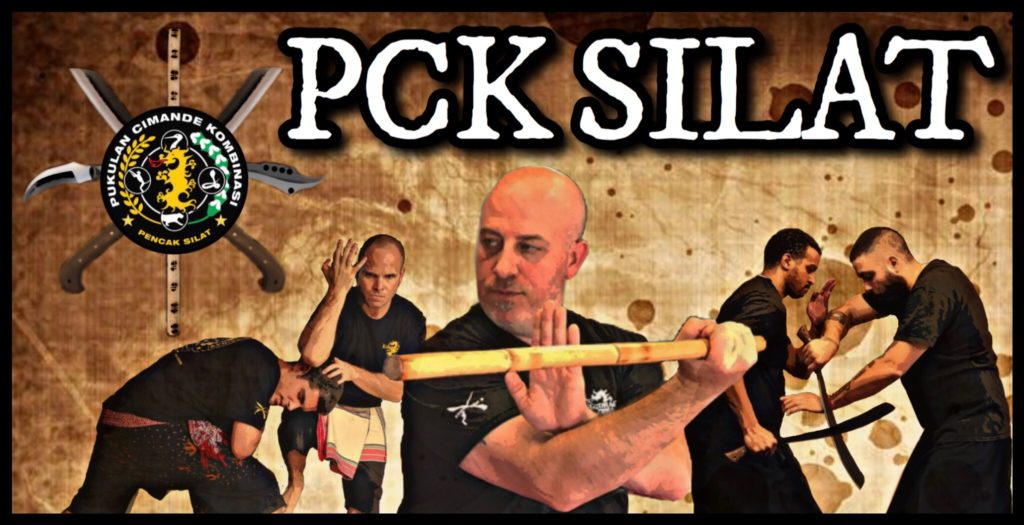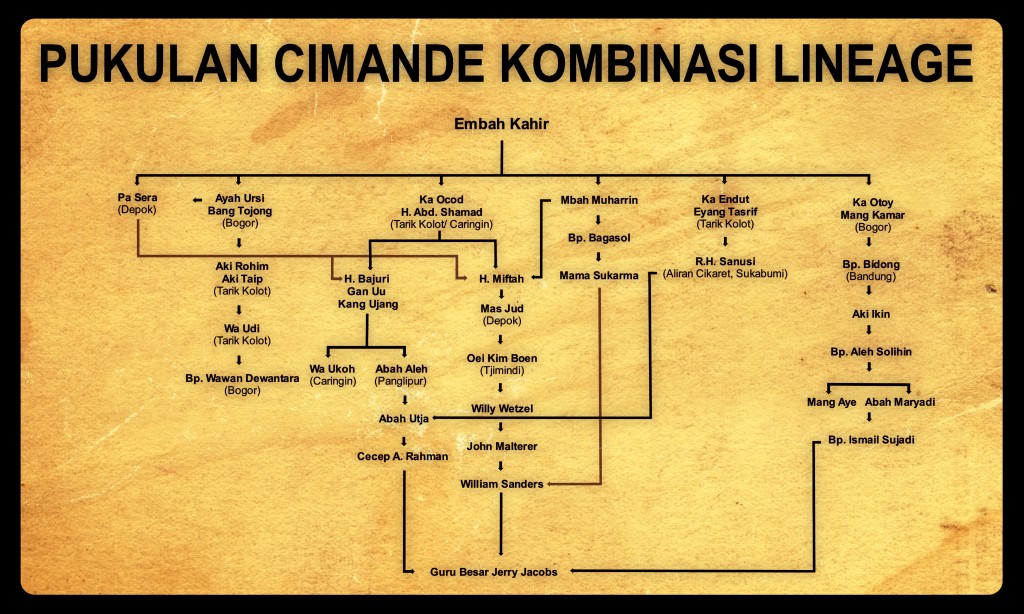PCK HISTORY
Pukulan Cimande Kombinasi Pencak Silat is a combination of multiple streams and lineages. Our main lineages are Cimande and Sera. While our style is based mainly on these two systems, we do not separate them in our expression. PCK Silat is a combining of streams. Combining these streams we create a unique style of Pencak Silat that can be learned no where else.
For the sake of education I will isolate the different aspects of PCK to show where each comes from and how they fit together. Each influence can be seen in more detail by choosing the individual art or influence in the side menu. Within the general history below, each influence is mentioned to give you an an idea as to where you should look to research a particular part of the art and where it comes from. I have added a section for the main streams of Cimande and Sera which include all lineages that influence us through each. I have also included individual sections on a few of the major influences.
PCK LINEAGE CHART
All of the material within the scope of PCK Silat's syllabus comes from the teachers listed on the Lineage Chart below. These teachers all trace their lineage back to the founder of Cimande Pencak Silat, Embah Kahir or Pak Sera respectively. This chart shows how each individual influence on PCK Silat traces its line back to the source of their stream.
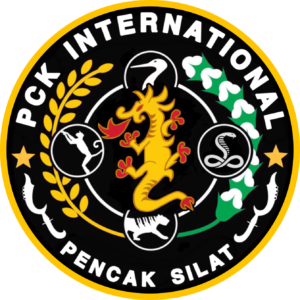
Pukulan Cimande Kombinasi is not simply a combination of these styles, it is a unique stream with an energy all its own that can only be learned directly from one of our instructors.
Guru Besar Jerry Jacobs formed PCK International in 2009. He has a lifetime of Martial Arts experience to bring to PCK Silat. After many years of training in Pencak Silat with various masters, PCK Silat was formed and has grown to be an art unlike anything else available today. We focus on staying progressive, while maintaining a traditional feel to our training and an identity as a system that adheres to the old ways of training combat and meditation as well as learning about Sundanese culture. We keep one eye on the past and one on the future. Striving to be innovative and stay modern in our approach to the art while still honoring the past. We must always continue to grow as an art, and this does not have to take us farther away from our roots, nor does it require that we stray away from our Lineage. It is a sign of a true master in my opinion to have continuous growth and development within a system while still staying true to the art. Guru Besar has been relentless in his pursuit of knowledge as has maintained a true heart throughout that search, seeking to find the roots of our art to further his students knowledge and pay respect to our Lineage.
PCK Silat was formed in 2009 with the goal of spreading Pencak Silat within the U.S and internationally. We have schools and training groups established around the world with more spreading each year. We have taken the Cimande and Sera elements from the various sources and brought a new energy and a new art to the world.
Our system beyond the Sera and Cimande influence is based on the movements of 5 animals. This is where the expression of these elements reach their full creative potential. These elements of our art are derived from the animal systems taught through the Wetzel lineage and from the development of those techniques by William Sanders as he trained with countless masters before passing his knowledge on to Guru Besar Jerry Jacobs over many years.
Cimande and Sera as arts stand alone as symbols of what true Pencak Silat is all about. PCK Silat is rooted in these arts but these animal fighting techniques and mannerisms bring our Cimande and Sera to life.
We utilize the fluid as well as erratic aspects of the Monkey, with its evasiveness, ability to adapt and flow as well as relentlessly hit, this gives our movement the softness required at times for sensitivity and the ability to employ our primal instinct to survive in an instant. Monkey offers a glimpse into the finer points of the use of Tarik (Pulling) and Darong (Pushing) and causing disorientation and off balancing in opponents. Some of the more sensitivity based training we use comes from our Monkey system. Some of these methods are derived from the influence of Cikalong in Mas Jud's art. We also get some langkah and our spider web footwork pattern from this Cikalong influence. From Mas Jud and the Wetzel lineage we get the base of our Monkey movement and concepts and also from the Cimande Tarik Kolot influence we have some Pamonyet movements derived from the Jurus taught within their system.
Within our Tiger (Harimau/ Macan) movement you will find the powerful, crushing, penetrating type hitting as well as leaping, the hunting of the lower body from the ground, breaking, hunting of the head and neck for control of the body when upright and taking the opponent to the ground with powerful yet graceful destructiveness. Harimau is our fully grounded tiger and it brings our Jurus, kicks and principles to the ground fighting game. From the more upright Harimau positions that use multiple points on the ground for balance and power, we can use kicks, punches, jurus as well as all of the 18 principles of PCK Silat. We also move all the way to our back like a cat with all 4 limbs free to attack. The tiger also has a fully upright expression (Macan). Here we bring out some of the most destructive nature of our striking. With it's directness and eagerness to end the fight as quickly as possible this is a devastatingly effective style of fighting. William Sanders sources of Harimau and Cimande Tarik Kolot's Pamacan movements from the 5 Jurus taught within their system combined with Guru Besar Jerry Jacobs continued study of Harimau and Macan make this a very deadly aspect of our art. Traditional Cimande from Panglipur uses some ground fighting also and these elements are incorporated into our ground fighting also.
Our snake system utilizes the more compact expression of our Jurus and kicks as well as mannerisms of the Cobra that dart rapidly hunting the limbs using "Poison Hand" techniques to immobilize a limb before wrapping and breaking (Python). This rapid fire Pukulan style of hitting is one of our systems trademarks. This is our close range fighting and it includes vicious knee and elbow attacks, kicks that hunt the muscles and nerves in the legs and wraps and breaks that leave an attacker unable to fight back effectively. It is said that the snake aspects of Willy Wetzel's art are drawn from Mas Jud's own family snake system.
The Crane has our longest range weapons and movement and uses speed, lightness, whip and ricochet movements. It uses sweeping motions, wrist blows, gunting (scissors) type striking along with the scanning head movements and upright one legged positions. The Kilap footwork and unique torture strikes with the finger tips (usually to the eyes or face) make our crane much more combative than what most people have seen. This style is also attributed to either Mas Jud's or Willy Wetzel's training outside of Cimande and Sera, possibly with other Silat or Kuntau practitioners in his area.
Lastly we have the Naga. Combining all of the animal mannerisms and expressions of the Jurus and Langkah into one destructive yet mesmerizing synthesis of concepts, principles and energies. The Naga of PCK brings the essence of each of our streams together into one. Again, we do not isolate our Cimande and Sera material, but blend them seamlessly into one art. The Naga represents the combining of all elements, animals and energies within our system and therefore is the center of our PCK logo, representing the coming together of all of the streams into one.
Weapons of PCK
PCK Silat is a blade based art. We train multiple types of bladed weapons, but we also teach impact weapons such as the Kancing Stick, Standard Stick and short staff. We also train Sarong fighting techniques as well as improvised weapons.
Indonesia is rich with history. Many cultures have made their way through this beautiful and mysterious country and have all left traces of their presence in certain ways. The weapons of West Javanese Silat reflect that rich history.
In PCK Silat we train weapons in a unique way. There is an approach to training that Guru Besar has always maintained that I believe makes our weapons training more effective. We train each weapon three ways. First, we look deeply into the function and make-up of the weapon itself by studying Jurus specific to the weapon and what makes it unique. We learn about basic mechanics, cutting or striking surfaces and what the weapon was made for and how it can be used to inflict as much damage as possible.
Second, we learn how the weapon relates to the rest of the art and how to move the weapon with the Jurus, Animal Mannerisms and Drills that might otherwise seem unrelated. This brings the weapon into the hand of the practitioner as an extension of the body and the art. You learn at this point to think of your movement as a whole. How your striking, footwork and body positioning in all situations can effect the blade for good or bad. We also supplement this training with slow free flowing meditative movement to gain knowledge as to how it moves in relation again to the rest of the art and the body in general. To treat the weapon as an extension of the body, it has to become a part of it, to the point where you no longer have to think about your movement. You know your blade, and the right and wrong way to move it. This is done in a detached slow moving manner and gives students enhanced sensitivity through the blade and a sense above and beyond just kinestetic, allowing them to feel comfortable moving the weapon in any direction, in any form without thinking.
Lastly is the combination of these training methods. Knowing the blade and it's limitations and how to adapt to overcome them the student then makes this knowledge, one flowing combative expression.
We will begin our look at PCK's weapons by looking at one of the most recognizable weapons of Indonesia, the Kujang.
Kujang
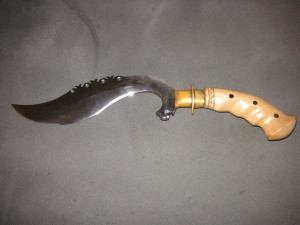
The Kujang is a deadly blade said to be made in the image of the Island of Java itself. It is a highly valued weapon and is held in the same regards by most Pesilat as a Keris.
The Kujang training in PCK is combative. This is not to say we do not hold the Kujang in the same high regard and status as other arts, but rather that we honor it's status and its history by teaching about it's spiritual and cultural aspects as well as a weapon used in combat throughout Indonesia's history.
We teach 11 Kujang Jurus that come from our stream through William Sanders. He trained extensively with Pendekar Suryadi Jaifri and these Jurus come from him. These Jurus teach basic cutting, grips, striking angles and targets, as well as grip switches. They cover multiple height levels as well. These Jurus combined with training in the general use and function of each portion of the blade gives students a deep understanding of how to use this weapon and then the further expansion of those concepts by applying the art itself make it deadly in the hands of a PCK Silat practitioner.

William Sanders and Suryadi Jaifri training Kujang
Pedang
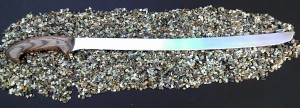
The Pedang is our long sword. Pedang is a word used to describe a sword and many blades found in Indonesia and Malaysia share this name, similar to how a Parang comes in many varieties and lengths. It is used for slashing and thrusting motions mainly and has a thick spine and comes to a point at the tip of the blade. Our Pedang Langkah, which contains the essence of our Pedang movement, comes from William Sanders. This Langkah holds the keys to the style of sword movement PCK Silat uses and covers multiple attackers, cutting angles, slashing, thrusts, reverse grip, grip switches as well as blending in a few of the 18 principles of PCK. Sanders also developed a method of training called "Cleansing the Body With the Blade" which is a meditative type movement (described above).
Pisau
The Pisau is our small knife. While we do train with traditional sized blades, it is more common to see PCK practitioners training with pocket knife sized blades. Our Pisau material is a combination of the information from Guru Besar Jerry's extensive training with William Sanders, his training in multiple Kali systems (Pekiti Tirsia, Sina Tirsia Wali) as well as his own personal development. Some of Mas Juds snake system made its way into our system with the darting cobra mannerisms and in close snake body positioning as our standard knife positioning. Our short blade work is deadly. There are multiple areas of the empty hand portion of the art where knife/ blade applications and defense are built in. In PCK Silat we put a strong emphasis on knowing the blade beyond the basic cutting angles. Guru Besar Jerry teaches applications out of all Jurus and Animal Mannerisms with the blade as well, making our blade work unique to our system.
More coming soon...
